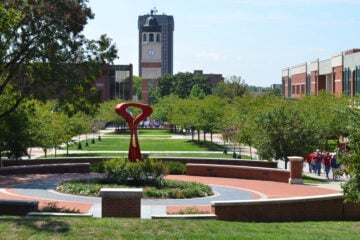Options run out in Ohio college town as licensee guts its pubradio budget
In a southwestern Ohio college town, the public radio news station with seven full-time employees will become an unstaffed repeater for Cincinnati Public Radio under an agreement announced Jan. 22 [2009].
Miami University, which began looking for ways to end its funding of WMUB-FM two years ago, negotiated the preliminary deal as it struggled to close a projected $22 million budget shortfall for the fiscal year beginning in July.
A university study committee endorsed a proposed three-way partnership with stations in Dayton and Yellow Springs in September 2007, but the plan fell apart about a year ago. Operating WMUB independently was not viable, the committee concluded, because its potential for income growth was too limited to significantly reduce Miami’s annual subsidy.
“We find ourselves in a position in which we have to move more quickly,” said David Creamer, v.p. of finance and new business for the state university in Ohio’s Miami River valley. The university officials enlisted Public Radio Capital, the Colorado-based nonprofit financing consultancy, to find a new operator for the station. WMUB managers did not know about the university’s plan until the deal was done.
“Everyone knew that Miami was going through severe belt-tightening, and there was discussion about layoffs and position eliminations,” said Cleve Callison, WMUB’s g.m. “My hope was that we might be looking at sharp cutbacks, but not a complete elimination.” The announcement came 10 days before WMUB was to mark its 59th anniversary of broadcasting from Miami’s campus in Oxford.
Cincinnati Public Radio, which became a two-station operator by acquiring Xavier University’s WVXU in 2005, is slated to begin running the Miami University station March 1, though WMUB’s seven full-time and three part-time staff members will stay on the university payroll until June 30.
Two pubTV licensees in the region also merged recently — WCET in Cincinnati and WPTD/WPTO in Dayton.
WMUB is the smallest of six public radio stations serving southwestern Ohio. Its primary broadcast area is largely rural, but its signal reaches a population of 500,000 — mostly in the suburbs and small towns between Dayton and Cincinnati. “The other stations focus on one market or the other,” Callison said in a 2007 interview. “We don’t serve all of either one. We serve parts of both.”
“One of the major problems with WMUB is that the community is limited in the demographics and population size to support the station,” said Richard Eiswerth, president of Cincinnati Public Radio. “That’s why it received an inordinate amount of support from the university.”
In 2006, before the belt-tightening began, Miami provided more than $1 million to operate WMUB, according to a background report presented to the university study committee. Nearly $342,000 of that was in-kind support. This year, Miami is contributing $500,000 to pay for staffing and providing indirect support worth roughly $300,000. “God knows we tried, but we were never able to get off the dole of the university,” Callison said.
Talks stalled while clock ticked
When it examined the options for WMUB in 2007, the study committee didn’t recommend an alliance with Cincinnati Public Radio. WMUB’s signal isn’t strong in Cincinnati, said Richard Campbell, committee chairman and head of the university’s journalism program. Plus, CPR had taken on $15 million in debt when it bought WVXU.
The committee found the greatest potential for a collaborative partnership on the northeastern end of WMUB’s broadcast area, with Dayton classical station WDPR and WYSO, the NPR News and Triple A music station in Yellow Springs.
With a nod from Miami and a grant to work with Public Radio Capital on a strategic plan for the partnership, WMUB began preliminary talks with its pubradio neighbors to the north, Callison said.
But Antioch University, WYSO’s licensee, was grappling with its own financial challenges and became embroiled in controversy over its decision to close the campus of Antioch College in Yellow Springs. Paul Maassen, the WYSO g.m. who agreed to pursue the regional partnership, also left the scene, accepting the g.m. position at WWNO in New Orleans.
Uncertainty over WYSO’s participation “clouded the situation,” said Richard Little, supervisor of WMUB and special assistant to the provost. The other two stations could not proceed to form a partnership without WYSO, he said.
“If station management had gotten on this early and turned from WYSO to look at other options, they could have structured this with Cincinnati Public Radio,” Campbell said. “Maybe there would have been a better way to structure it so everybody wouldn’t have lost their jobs.”
“I don’t think anyone saw this financial crisis coming, and all of a sudden there was no time and the university did what they needed to do,” Campbell said.
Miami faces the same financial challenges as most public universities: cuts in state funding coupled with caps on tuition. The collapse of the stock market last fall exacerbated the problem. “We are very dependent on our endowment, and our investments have been harmed substantially by the decline in the financial markets,” Creamer said.
Last October, Miami President David Hodge asked Callison and Little to lay out other options for WMUB, according to Little. They proposed a partnership with Cincinnati Public Radio that preserved WMUB’s local programming but saved only $100,000 from the university’s budget, he said. The pair also proposed establishing a major-giving program that, given time, could have reduced WMUB’s reliance on the university.
“What we were talking about was holding fast and raising the money over several years,” Little said, “or seeing what we could do with a significant but not crippling budget cut.”
“When the administration realized that they needed to meet a budget-cutting target of $22 million, that drove a rapid decision to eliminate the funding for the station altogether,” Little said.
About this time, Callison said, it was made clear “that I was not supposed to be talking to Cincinnati Public Radio. So I didn’t.”
When revisiting their options for WMUB last fall, Miami officials also considered selling the license, according to Creamer. “That would have likely meant the end of public radio service in the area covered exclusively by WMUB, and it limited our opportunities for academic partnerships with the operator,” he said. “We had to evaluate it based on our responsibility to our students and the public, and we didn’t feel we would get the greatest value in that direction.”
As many as 200,000 potential listeners in WMUB’s service area receive no other public radio signal, according to Public Radio Capital’s Erik Langner, who is facilitating the deal. Miami officials recognize that public radio is a “precious resource to the community” and asked PRC to find an operator who would take over the costs of continuing to provide pubradio news and information. “Our specific mandate was to preserve the format,” Langner said.
Under the operating agreement, which must still be finalized, Cincinnati Public Radio will retain revenues raised from WMUB’s listeners, and Miami will be relieved of the $500,000 annual cost of staffing the station, Creamer said. The university will still pay some indirect costs related to WMUB, such as utilities and audit fees.
Initially, WMUB will be a repeater for WVXU, Cincinnati Public Radio’s NPR News station, but later the station group may add a “modest” amount of local programming, Creamer said. Eiswerth has asked Miami to maintain one studio on campus, and Campbell is working to continue a pubradio internship program for Miami journalism students.
The agreement carries some risk for Cincinnati Public Radio, given the limited potential for listener contributions in WMUB’s service area, Eiswerth said. Debt payments from the acquisition of WVXU are substantial, he said, and the economic downturn has put the Cincinnati stations in “serious financial straits” of their own.
“We’ve had to reduce force and cut benefits, and we’ve frozen salaries and eliminated travel,” Eiswerth said. “This is not coming to us in an ideal time in our financial history, but we have a commitment to the listeners of the greater Miami Valley, and we’re making an assumption that we’ll at least be able to cover our expenses if we take over the operation as a repeater.”






